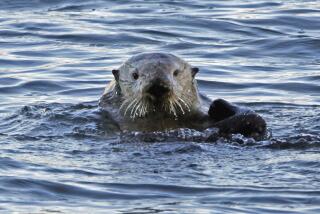Rescue of Oil-Soaked Sea Otters Is Guided by Costa Mesa Man
- Share via
Ten days after an Exxon tanker ripped apart on an Alaskan reef, Costa Mesa businessman Jim Styres was hovering over Prince William Sound in a helicopter, working with wildlife biologists to save oil-drenched sea otters.
And this week, 1 month after the largest oil spill in U.S. history, Styres was not only still on the scene, he was leading 130 veterinarians, biologists and volunteers in building and directing an Exxon otter rescue center in Seward, Alaska.
A print-shop owner by trade, the 40-year-old Styres became an expert on sea otters while working at the Seattle Aquarium in the early 1970s. He also runs a marine mammal consulting business that has sent him overseas to capture sea lions and killer whales as well as sea otters.
Because of his background, San Diego Sea World’s Randall Davis, who was heading an otter rescue center in Valdez, asked Styres to join him soon after the March 24 spill in Prince William Sound.
Styres arrived in Valdez on April 4 and was shocked at his first sight of the otters. They were shivering, he said, and their fur was matted and covered with thick, black crude oil. “It’s devastating,” he said. “It really tears you apart.”
But over the past 3 weeks as he worked one 16-hour day after another, the shock has worn off. “I imagine it’s much like being in a MASH unit, in a war,” Styres said. “You get hardened by it and then you just get out and work.”
During his first 5 days in Alaska, Seward was part of a team that scanned the coast for disabled sea otters. Biologists would net the oil-soaked animals on rocks or on the beach. Styles would help ferry them by helicopter to the rescue center where the oil would be scrubbed off.
It was a tricky business, Styres said, because sea otters--even sickly ones--can inflict a vicious bite.
“The sea otter’s skin is very loose fitting, like one of those Chinese-wrinkle dogs. And they can turn in their skin. Grab an otter and he can probably spin around on you and nail you,” Styres said.
“They have what we call in the business a ‘cuddle quotient,’ ” he explained. “They look very cute and cuddly. But you don’t want to grab hold of them. They’ll tear you apart.”
After nearly a week in Valdez, Styres was named by Exxon to head a second otter rescue center in Seward, a port city 100 miles south and west of Valdez, on Resurrection Bay.
Styres, with his knowledge of business and otters, was the natural choice to head the new center, according to U.S. Fish and Wildlife biologist Glenn Van Blaricom. “Most research biologists are pretty hopeless when it comes to managing a business and personnel,” Van Blaricom said. “We needed a good manager. And Jim’s a strong communicator and very methodical--and he knows sea otters.”
In his 2 weeks in Seward, Styres has spent his time negotiating a lease, designing the new otter facility, requesting building materials, and keeping track of 30 paid staff members and 100 local volunteers who are helping with the effort.
Styres expects his new center to be finished and handling at least 25 animals at a time by early next week, but the center, which will operate around the clock, can also expand to take care of 75 otters if necessary, he said.
Styres expects to stay for 2 more months, then leave the facility with local volunteers who will be trained to care for sea otters.
Styres’ plans call for building a complex of eight trailers--a mix of washing bins, holding pens, an area where cool air will blow the otters’ fur dry, and an intensive care section where ill or anesthetized animals can be treated.
“It’s not designed to look pretty or win any architectural award,” Styres said. “Our first concern is to build a facility that will take care of the needs of the animal.”
‘Wash Him Down Real Good’
To clean an otter, Styres said, the animal is anesthetized and then “we wash him down real good for an hour and a half” with a diluted solution of Dawn dish-washing detergent. The animals are then dried and moved into intensive care until they emerge from the anesthetic.
“Then they’re moved to a holding pen and, depending on their condition, they’re either placed in a dry area, or a unit where they can get in and out of water,” Styres explained.
Because sea otters eat a quarter of their body weight a day, Styres figures that he will have to lay in hundreds of pounds of squid, clams and crab to feed them.
Styres said his wife, Dale, will be in charge of the sea otter nursery--that is if there are any pups. Because it’s whelping season, “we’re certain we’ll have a few,” he said.
Styres said he loves the way sea otters take care of their young. “The pups are born in the water,” he reflected. “The mothers float on their backs and the mother will have the pup on her stomach where he nurses.”
But though April is the season for baby sea otters, “we’re not seeing too many pups right now,” Styres noted. “We’re a little concerned. Obviously, the problem is the oil.”
More to Read
Sign up for Essential California
The most important California stories and recommendations in your inbox every morning.
You may occasionally receive promotional content from the Los Angeles Times.













